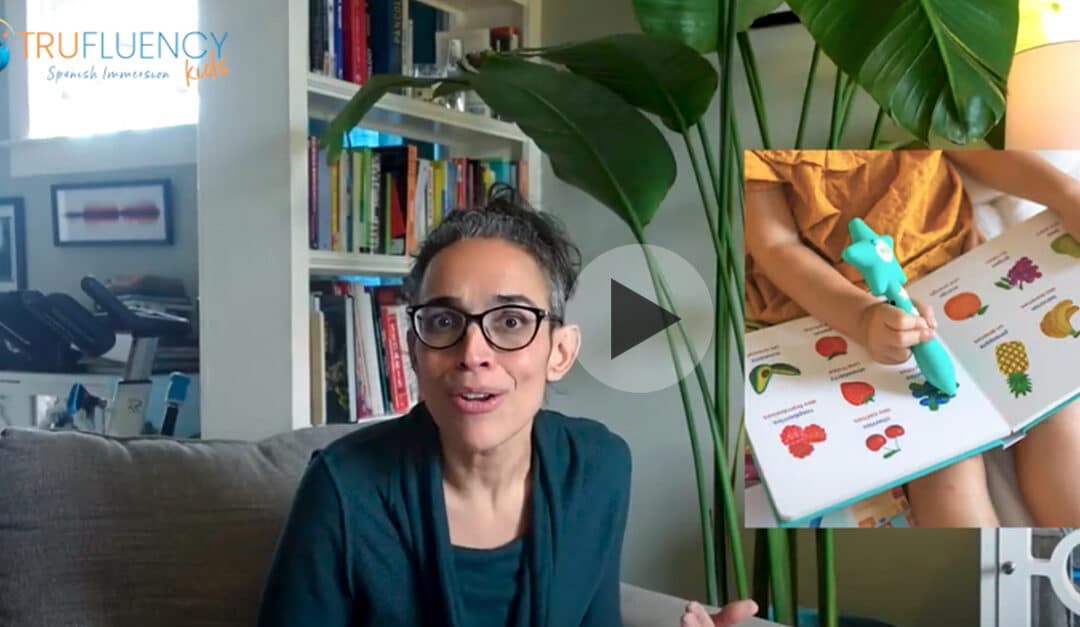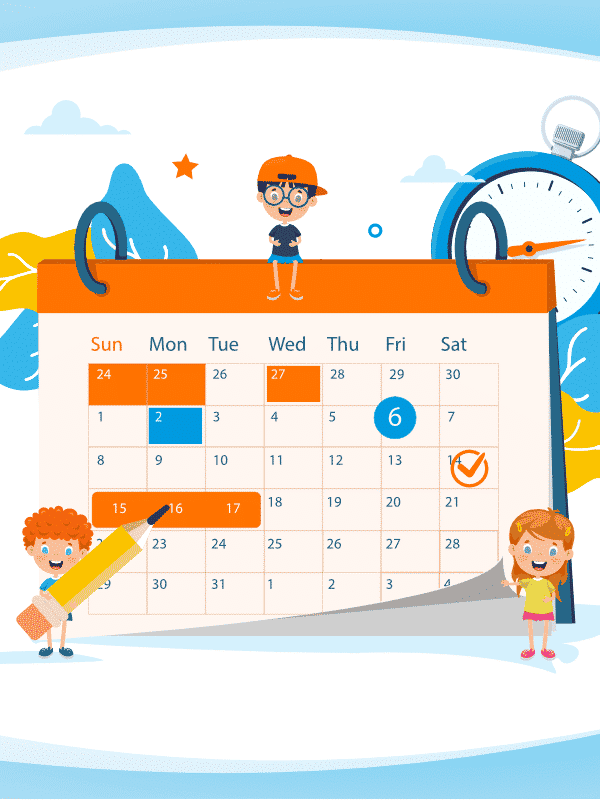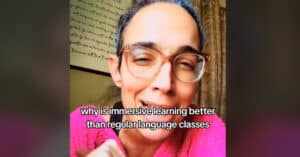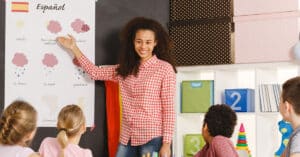Have you heard of Habbi Habbi bilingual books? This video discusses what Habbi Habbi really has to offer. Do their books really work?
What does ‘work’ even mean? You certainly can’t get fluent from a few books, but what can they do? What can you expect? And how can you use it best in your child’s language journey?
This is the key question for any bilingual resource – how are you going to use it to help your child’s fluency. Whether you’re a native speaker, or you’re learning with your child, or you’re a non native speaker who wants to add more resources into your child’s daily life, let’s get down to it.
What are Habbi Habbi Bilingual Books?
Habbi Habbi offers bilingual books for kids that want to learn Spanish, French, Chinese, Korean and Hindi. The text is written in English and the target language.
They also sell bilingual vocabulary flashcards with different topics, and bilingual puzzles, but we’re focusing on the books and the talking wand in this review, so the uniqueness of these books is obviously the talking wand.
My daughter just started getting the hang of it around age 2. She can tap it anywhere in the book and the book will say the phrase. Even the blank spaces of the book will make a sound, for example, the sounds of the forest if you tap on the trees, or animal sounds. Or just random music, which my daughter actually really gets excited about when she finds it.
The wand has three modes, the classic bilingual mode, the target language only and the English only mode. I use target language only with my 2 year old.
Since I’m only raising her in French, we can do this, but you might want to do bilingual mode if you’re a beginner. It’s not always obvious what the wand is saying in the target language without the English counterpart.
Will Habbi Habbi Improve My Child’s Fluency?
But here’s one of the most important questions we must ask ourselves as parents: how will I use these to further language acquisition And are they truly useful to us? Honestly, my main complaints about “language learning” books, in general, almost all of them, is that they don’t teach useful phrases we would use every day.
I don’t know why they teach un-useful phrases, but they often do. And some of the Habbi Habbi books miss the mark also – like the Things that Go book. Maybe someone out there is saying ‘sedan’, but I doubt my kid will know what a sedan is for a few decades. I barely know honestly.
Second complaint about almost all ‘language learning’ books. They only give words. But not sentences to use them in. I would suggest ‘what type of car is this?’ ‘it’s a truck’ as a way to interact with the books in a more useful way. If these are for kids over 2 years old, then they are already speaking, so give them sentences, not just vocabulary.
And give them useful vocabulary, not the word sedan, station wagon, street sweeper, freight train and monorail… I get it, maybe some kids love all those things, but I think more space could be used to form dialogues and complete sentences over using some of this vocab.
The books are cool. My daughter loves playing with them, But in all honesty will Habbi Habbi books help your kids learn a language Again, vocabulary without context is not the best way to learn. Olly Richards and many other language experts agree, and I do too, that learning through stories is a million times more interesting, memorable and fun.
I will say, some of the books have mini dialogues, like the My First Phrases book, but I wish there was a picture to go with the answers. It’s just a big bubble with tons of questions next to a kid’s head. The phrases are not set next to pictures showing them what the phrase means, so without the English translation on the wand, they wouldn’t know what it was saying.
I understand the need for the translation, but it’s better to have at least some idea of what’s going on with pictures as well. since I like the wand to be in target language mode, this does not help my 2 year old understand what is being said by looking at the photos in the My First Phrases book.
Are Habbi Habbi Books Suitable for Your Child?
Next question: Is this suitable for your kid? In terms of age, Habbi Habbi founders state on their website that they create these books for preschool and early elementary ages. But they also emphasize that it can vary depending on if you have a bilingual environment at home and whenever you’re feeling like your kids are ready to start.
As mentioned, my 2 year old loves it and asks for it. I forgot to charge the wand this week and she was very upset. I already lost the charger, as I lose many things, so I wish there was a battery option as well for us scattered parents. I would love to let her play with it on her own as well, but the placement of the off button means that she turns it off at least once every minute, which is really annoying honestly.
And she can’t figure out how to turn it back on, because you have to hold the button for 5 seconds. I know it’s hard to move the on/off button, but guys, it’s in a really bad location for kids. She squeezes it, and it turns off, literally all the time. And then she’s screaming for me to help. I’m sure by 3 she will be able to turn it back on herself. I hope
How to Best Use Habbi Habbi Books
Next question – how can you utilize it best? First, we highly encourage parent involvement. Make time to play with your kids using their books. You could ask them questions about the story or the pictures if you’re utilizing this as a supplement to your language usage daily.
For example: point at one of the images and ask what’s that. That way you’ll encourage them to tap on the image you pointed at and to repeat what the wand says. If you’re not a native speaker, just look up questions on wordreference.com or ask a native speaking friend to be sure you’re asking it correctly.
Then make sure you’re using the words you learn from the book in your daily life. So I learned the word for faucet while using these books and now I daily use the word faucet when we wash our hands. Very cool.
The Technology Behind Habbi Habbi Books and Wand
How is the technology of the books and wand? Habbi Habbi sells their wands as easy to use. It comes programmed in the bilingual mode, but you can easily change the mode by pressing the buttons that come in the products, whether it’s a book, flashcard and puzzle.
They even give the options for users that have an old wand to update it for free by following the steps on their website. I haven’t updated mine yet, but I need to, because it keeps switching to bilingual mode, when I want it to be in the target language only.
I myself am a language teacher and a polyglot – English is my only native language. I learned Spanish around 26-30 years old C1 level, French between 32-38 at low B2 level, and Japanese is ongoing but currently at A2 level.
I’m also the founder and primary researcher at TruFluency Kids Spanish – our online Spanish school for kids starting at age 4, with extremely small group classes for ultimate speaking time. and I’m raising my daughter trilingual in English, French and Spanish. This gives me experience to share tips on how to use these bilingual books and all things language learning.
Here’s to fluency.
TruFluency Kids Can Help Your Kids Get Fluent
If you want your kids to learn Spanish, we’d be happy to recommend using Habbi Habbi Bilingual Books in tandem with TruFluency Kids classes. We focus on giving your kids that all-important conversational practice — no matter how much experience they have with Spanish.
Our classes are online, available on your schedule and taught by native Spanish speakers. And, most importantly, they’re fun. You can learn more about us at trufluencykids.com.
Check our testimonials and take a trial class. Then, enroll your kids for our next four-week session.





